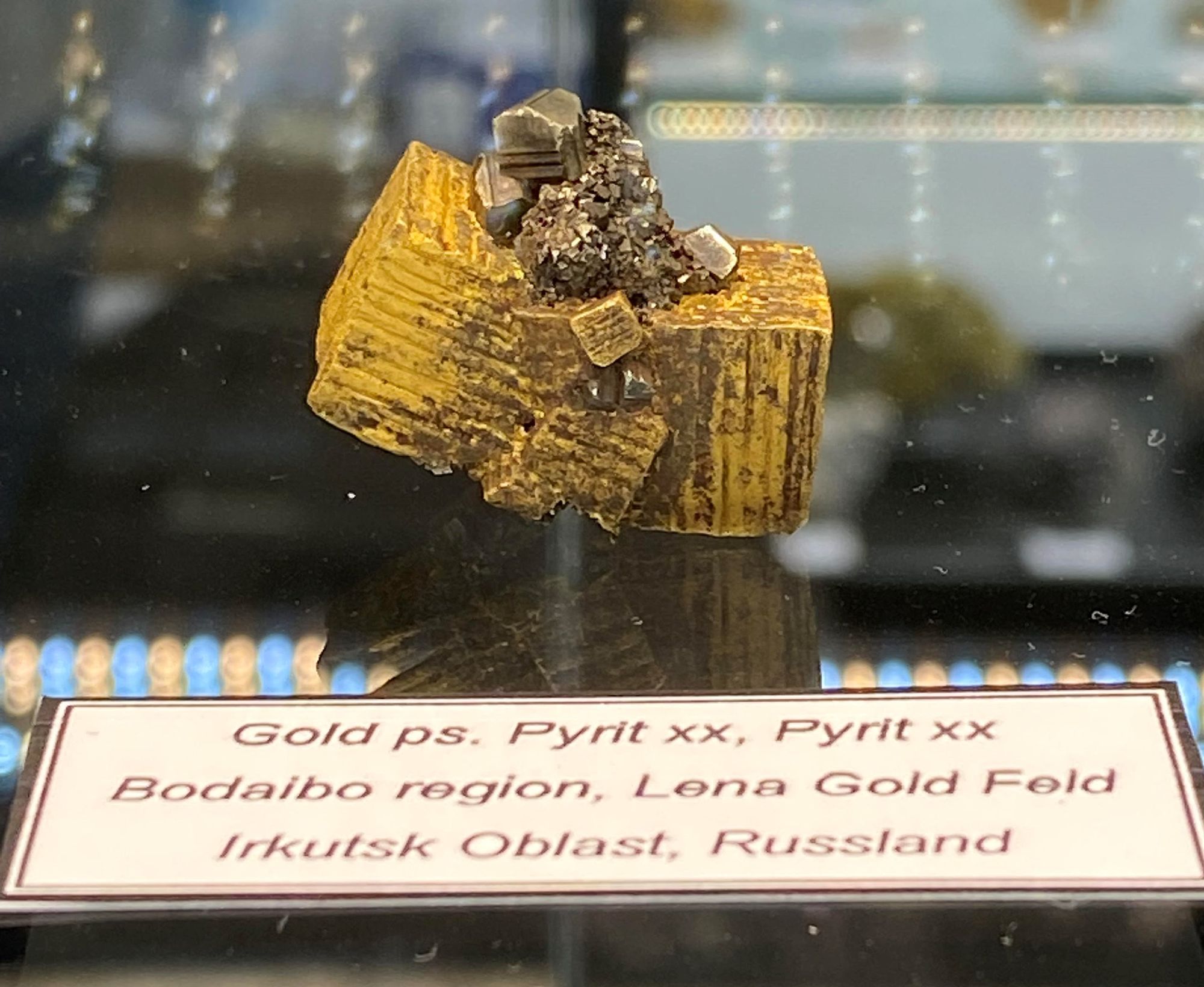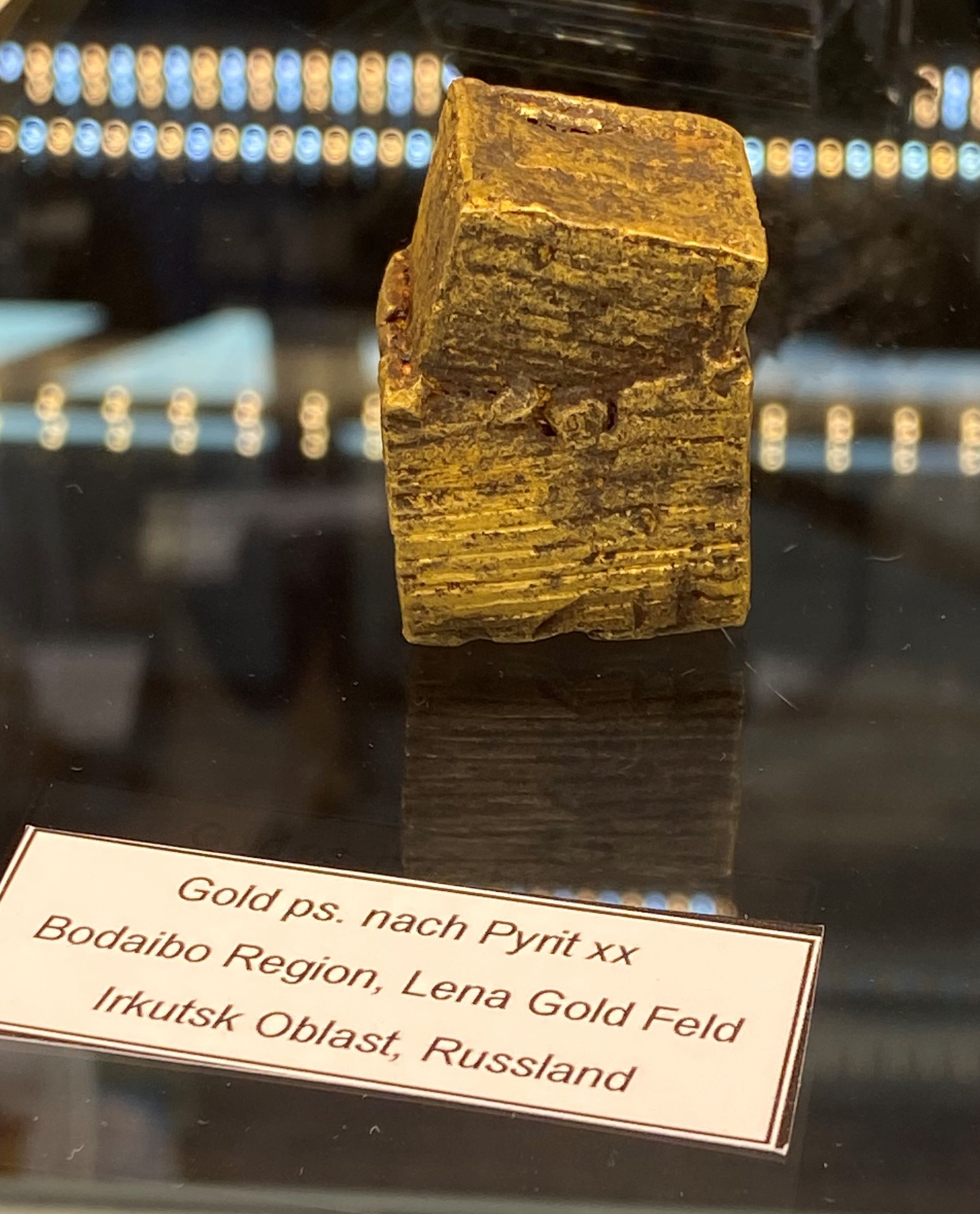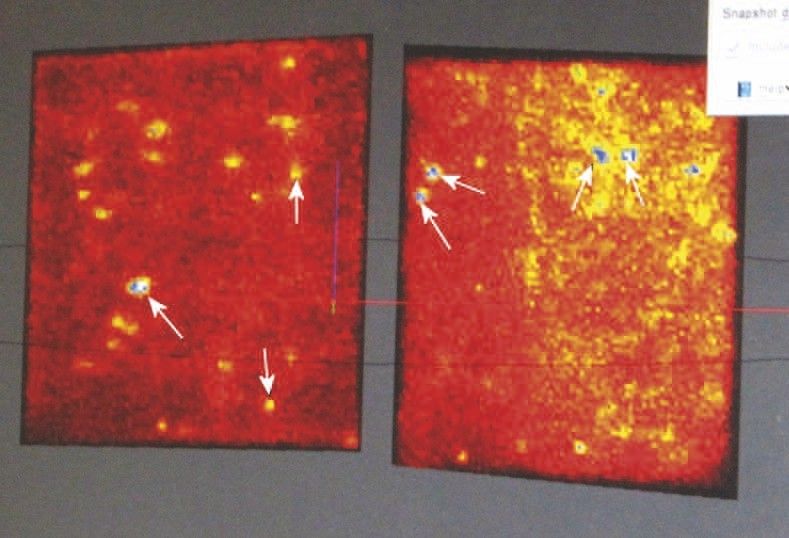Gold Pseudomorphs? Really?
by Ken Rock, MSDC Newsletter Editor
Source: Rocks & Minerals Magazine, Volume 92, September/October 2017. Used with permission of coauthor Dr. Volker Lueders. "Gold Crystals from the Lena Goldfields, Bodaibo Area, Eastern Siberia, Russia, Exceptional Hoppered Octahedra and Pseudomorphs after Pyrite."

Background
Have you ever been to a mineral show and seen something that was quite exceptional that really got you wondering about how it came to be? This happened to me recently at Europe’s big mineral show in Munich, Germany. My wife and I were in Berlin to visit our daughter who is in graduate school in Berlin and, as luck would have it, our visit coincided nicely with the October 2021 Munich show.
The two gold specimens in the above photo below are quite remarkable. Unlike most gold specimens that typically are found as nuggets, usually with signs of abrasive polishing by streams, or in quartz veins, these pieces were described as pseudomorphs on the labels. What a surprise – at least for me!

I asked the German-speaking vendor about them and he explained that they were from the Lena Goldfields in the Bodaibo area of Eastern Siberia. He also mentioned that he was coauthor of a technical article that was published in Rocks & Minerals magazine which he was later kind enough to share with me via email.

This writeup summarizes key aspects of that technical article and discusses the geology of the Lena goldfield deposits, some of the interesting history of this Russian occurrence, and perhaps most interesting, some of the testing that was done to evaluate whether these specimens are naturally created or if they were created by humans. In particular, the article looks at two distinct types of gold specimens: gold cubes with coarse striations (such as the ones shown in the photo above) and hoppered octahedral crystals (not on display at the show, but included in the article, along with some fabulous photographs).
Geology
Mining for gold in the Bodaibo area, also referred to as the Lena Goldfields, dates back to the 19th century when gold as first produced from placer deposits. The area consists of a succession of clastic carbonate sediments that are metamorphosed to greenschist and amphibolite facies and are intruded by granites of mid-Paleozoic age. The gold deposits are located in the southeastern margin of the Siberian Craton.
The principal sources of gold in the placer deposits are primary (lode) deposits, namely disseminated gold-sulfide mineralization in metamorphosed sedimentary rocks and more concentrated gold-bearing quartz veins. The gold deposits typically occur at a depth of about 50 meters or more and are difficult to exploit due to permafrost. Nonetheless, the Lena goldfields are still the most attractive targets for gold prospecting in Russia.

History
In the 1960s and 1970s, the former Soviet Union conducted a large-scale exploration program for metals at various sites in the country. Many of the gold crystals described in the article were reportedly found during prospecting by geologists between 1965 and 1975 and originated from an old prospect on the banks of the Ust-Urjach River. One of the geologists recounted that, after blasting, the gold crystals could be collected form the ground like mushrooms. However, at that time it was strictly forbidden to keep gold or platinum from state-owned mines. Thus, it was a great risk for the exploration geologists to keep specimens for their private collections. This also explains why there are not many examples of crystallized gold from the Lena Goldfields displayed in museums or that have been offered on the mineral specimen market.
Observations and Testing
The cubic gold specimens reviewed by the authors for the article include crystals with a cubic morphology either grown on quartz or without matrix. Most of the cubic gold crystals observed show well pronounced parallel striations on the cube faces, resulting in a relatively coarse surface topography. On any one cube face, the major striations are oriented in only one direction. The symmetry expressed by these striation orientations is inconsistent with the symmetry of gold, but is consistent with the symmetry of pyrite and the striated gold cubes strongly resemble pyrite crystals. This suggests that the cubes, if natural, may very well be pseudomorphs of gold after pyrite.

The second type of gold crystals studied is that of hoppered octahedra. The gold octahedra are often in aggregates and commonly associated with quartz. The octahedral crystals studied in the article are unusual in their highly symmetric development and the uniformity of the hoppered surfaces. To test the authenticity of a large single crystal of gold, one of the hoppered octahedra crystals was tested by neutron diffraction at the Los Alamos Neutron Science Center and Los Alamos National Laboratory, New Mexico.
The testing revealed that the sample is dominated by one large single crystal with a few volumetrically smaller and more weakly diffracting gold crystals. Based on the data, the authors concluded that the crystal pictured below is not a pseudomorph.

To further evaluate the gold cubes, the authors conducted a number of tests that included:
1) weighing the specimen to see how the actual weight compared to the weight of a pure gold specimen of the same size and studying the porosity of the specimens;
2) looking for internal evidence of pseudomorphism via scanning electron microscopy with energy dispersive analysis at the TU Bergakademie in Freiberg, Germany;
3) sectioning an additional cube, which was originally on a quartz matrix, and analyzing it by electron microprobe in Potsdam, Germany and then by electron backscattered diffraction in Berlin, and finally;
4) analyzing inclusions and surface precipitates by micro-powder X-ray diffraction and Raman spectroscopy at Miami University and the University of Arizona, respectively.

Based on these analyses, the authors noted that the high frequency of goethite and lepidocrocite in and on all specimens suggests weathering of primary pyrite. Furthermore, the presence of these minerals as inclusions in the gold cubes precludes the possibility that the gold crystals were cast from a melt. The analyses also showed a distinct chemical zonation with higher silver concentrations near the core of the crystal. Such zoning also is inconsistent with a cast specimen.
Gold on Quartz Interface
Some of the cubic and octahedral gold crystals are associated with, or are grown on, a quartz matrix. Two of these samples were put into acetone and methyl ethyl ketone to test if the gold crystals had been glued to the quartz. Neither of the crystals detached.
To further study the quartz-gold interface in these samples and to test for other adhesives (e.g., ceramic cements, solder, or mechanical pins), X-ray radiographs were taken in a dental laboratory in Berlin. No evidence of artificial adhesives was found. Based on the texture of the gold-quartz interface, the specialist who performed the radiography concluded that the gold was not treated mechanically and this was not forcibly attached to the matrix.

Summary and Conclusions
Data presented in the study include morphology, surface microtopography, surface overgrowths, and matrix interface characteristics for both the octahedral and cubic crystals. The authors concluded that none of the data are inconsistent with the hoppered octahedral crystals being true single crystals and the striated cubes being true pseudomorphs after pyrite. In other words, there is no evidence that the samples studied were manufactured. Given that gold and pyrite are commonly found in association worldwide, it may be somewhat surprising that such pseudomorphs have not been seen more often and suggests that rare geochemical conditions are necessary for their formation.
Authors of Original Article
JOHN RAKOVAN, Department of Geology and Environmental Earth Science, Miami University, Oxford, Ohio 45056, rakovajf@miamioh.edu
VOLKER LÜDERS, Helmholtz-Zentrum Potsdam, Deutsches GeoForschungsZentrum Section 3.2 Telegrafenberg, 14473 Potsdam, Germany, volue@gfz-potsdam.de
ANDREAS MASSANEK, TU Bergakademie FreibergGeowissenschaftliche Sammlungen Brennhausgasse 1409599 Freiberg, Germanyandreas.massanek@geosamm.tu-freiberg.de
GERT NOLZE, Federal Institute for Materials Research and Testing, Department 5: Materials Engineering Unter den Eichen 87, 12205 Berlin, Germany
gert.nolze@bam.de
